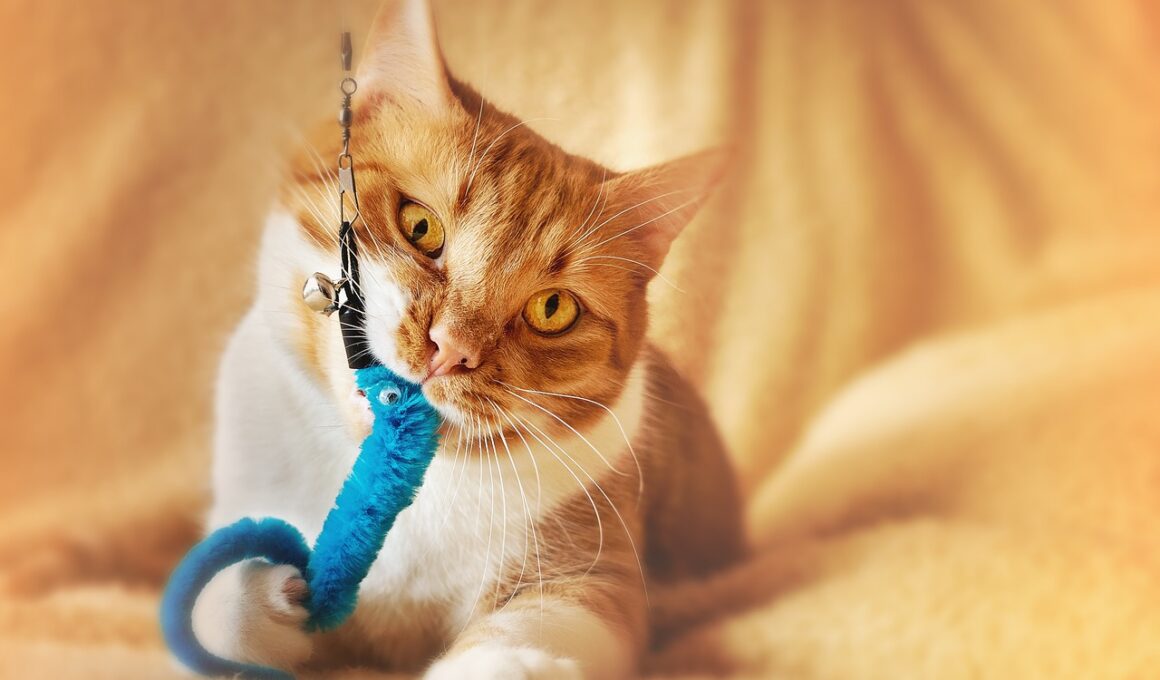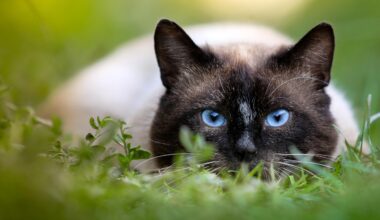Why Playtime Matters: The Psychology Behind Cat Toy Preferences
Understanding the psychology behind why cats prefer certain toys is essential for enhancing their playtime experience. Cats are natural hunters, and their predatory instincts play a significant role in toy selection. Choosing the right toys can stimulate their innate behaviors, leading to more enjoyable interactions. Soft toys often mimic the texture of prey, making them favorites for many feline friends. A cat’s sense of smell also influences their toy preferences. Some toys are infused with catnip, elevating the playful experience significantly. Additionally, the size and movement of a toy are essential. Toys that bounce or have unpredictable movements pique a cat’s interest, fostering better engagement. Various materials can enhance a toy’s appeal, including squeaky toys or rattling options that encourage the cat’s hunting instincts. Furthermore, complexity matters; some cats thrive on puzzles or interactive options that challenge their problem-solving abilities. In contrast, others may prefer simpler toys that require less effort. Understanding these preferences can lead to a more enriching life for your cat and a deeper bond between pet and owner.
One of the most influential factors for stimulating cat behavior through toys is the concept of play. Play serves as both a physical workout and a mental challenge. During playtime, a cat engages with their environment, honing their reflexes and skills. By providing various toys, owners can create an engaging atmosphere where cats can explore their instincts. There are different categories of toys that stimulate these behaviors. Chasing toys, such as feather wands, allow cats to practice their ambushing techniques while engaging their minds. Other options, such as laser pointers, trigger their chase response remarkably. It’s vital for owners to be familiar with these kinds of toys and how they can channel their pet’s energy effectively. Interactive toys that encourage participation can also be quite stimulating, such as those with treats or sound effects. Keeping toys fresh and rotating them is equally crucial, as cats can quickly lose interest in the same ones. Owners should aim to introduce new textures, shapes, and functionalities to maintain the novelty and enrich their cats’ play experiences.
The Importance of Sensory Stimulation
Sensory stimulation is critical in understanding how cats interact with toys. Toys create opportunities for cats to engage their senses of sight, sound, and touch, crucial for mental health and emotional well-being. Interactive and textured toys instigate various reactions in cats, often leading to heightened excitement. Toys that have contrasting colors capture their attention more effectively. Incorporating visual elements with movements like rolling or dangling can trigger their natural hunting tendencies. Furthermore, auditory stimulation also plays a significant role. Therefore, owners may consider toys that produce sounds, like crinkles or squeaks, packing more excitement. Additionally, scent can be a powerful influencer; many cat toys are infused or designed with appealing scents to encourage engagement. As sensory stimulation increases, cats may demonstrate more enthusiasm in play, leading to healthier and more active lifestyles. This is particularly important for indoor cats that may not have the same opportunities to hunt as outdoor cats do. Engaging them actively through various sensory play options can greatly enhance their contentment levels and overall happiness.
Another essential factor in cat toy preferences is the importance of social interaction during playtime. Cats may exhibit a variety of behaviors that signal their mood and preferred interaction styles. For instance, some cats may prefer solo play, while others thrive on engaging with their owners or other pets. Understanding these personality traits can help owners choose the ideal toys for fostering such interactions. For instance, toys designed for tug-of-war or fetch facilitate teamwork between a cat and its owner. This helps strengthen their bond and establishes trust. Moreover, playing together allows for creative opportunities to engage with different types of toys. Toys with bells encourage fetch, while cozy hideaways can invite shared exploration. Cats’ moods can vary significantly; sometimes, they may prefer interactive engagement, while at other times, solitude is best. Rotating toys can enhance social interactions as cats become more interested when they are periodically changed. Owners should pay attention to their cats’ body language during play, adjusting the type of toys accordingly. Establishing a varied approach can enhance their overall play experience.
Health Benefits of Playtime
Playtime with toys not only provides joy and stimulation for cats, but it has some extraordinary health benefits. Engaging in regular physical activity helps maintain a healthy weight, strengthens muscles, and improves coordination. Obesity is a common problem among indoor cats, making regular play essential for preventing this issue. Active play sessions encourage cats to chase, pounce, and exercise, giving them a healthier lifestyle. Additionally, mental stimulation through toys helps to alleviate boredom, which can lead to destructive behavior if left unchecked. Keeping their minds sharp with engaging toys can help decrease anxiety and stress levels. As cats age, maintaining mental agility through play becomes even more critical. Toys that challenge their cognitive abilities, such as puzzle feeders, are excellent choices for older cats who may lose interest in more traditional toys. Moreover, interactive play sessions foster a regular schedule, which can contribute positively to the overall routine of your feline friend. Incorporating playtime into their daily activities offers a reliable way to give them what they crave while also benefiting their mental and physical health.
The selection of toys must also consider the individual preferences and personality of each cat. Many cats showcase distinct behaviors that clearly communicate their likes and dislikes. Just as some cats prefer chasing after feathered toys, others find more enjoyment in soft plush toys. Observing their behavior is crucial for selecting the appropriate toys, catering to unique personalities which can vary tremendously. Engaging with toys that align with their style will provide maximum enjoyment during playtime. Additionally, each cat’s age plays a pivotal role in toy preference. Kittens are generally more energetic and exuberant, finding thrill in feral-like movements as they practice their hunting skills. Adult cats may prefer slower, more calculated play, while senior cats often enjoy gentle, softer interactions. It is also essential to note that providing toys that present difficulty might lead to frustration. It’s important to strike a balance between challenge and accessibility; overly sophisticated toys might deter them from play altogether. In the end, the right mix of play options will contribute to a well-rounded and happy cat.
Conclusion: Crafting the Ultimate Playtime Experience
Crafting the ultimate playtime experience requires enhancing understanding and recognition of cat behavior, preferences, and needs. Investing time in selecting suitable toys, engaging in regular play, and keeping toys fresh can lead to an outstanding environment for both owners and their cats. Recognizing play as an integral part of a cat’s life is vital for ensuring their happiness and well-being. By experimenting with varied toys across different sensory experiences, enrichment opportunities increase significantly. Additionally, as personalities vary among cats, being adaptable to their changing preferences is key to sustaining interest. Utilizing a combination of social play and solitary options can greatly improve the bond between owner and cat, making playtime enjoyable for both parties. This dynamic can transform playtime into something more rewarding, both physically and emotionally, solidifying companionship. Finally, recognizing the health aspects linked to active play sessions makes it even more significant for overall lifestyle enhancement. With thoughtful approaches to playtime, we can enrich their experiences and ensure a healthy and happy life for these fascinating creatures.
Exploring the vast range of cat toys available can lead to a fulfilling journey not only for the feline but also for its owner. Knowing how to keep your kitty engaged and entertained can result in memorable moments that are meaningful. Equipped with knowledge about toy styles, functions, and behaviors, you can take playtime to the next level, ensuring a dynamic interaction that fosters a healthy and enjoyable environment.


